
27
UAB KOMFOVENT we reserve the right to make changes without prior notice
RHP PRO_22-01
3.6. Connection to Air Ducts
•
Ducts connecting the unit to the exterior of the building must be insulated (insulation thickness
50–100 mm) to prevent condensation on cold surfaces.
•
Air intake and exhaust ducts must be fitted with air shut-off dampers (electric with actuators) to
protect the unit from exposure to climatic conditions when the unit is switched off.
•
In order to minimise AHU generated noise and noise transferring through the ducts into venti-
lated areas, sound suppressors (silencers) must be connected to the unit.
•
Air duct system elements must have separate brackets and must be mounted in a way that their
weight is not shifted to the unit casing.
Air ducts shall be connected to flexible unit connections, flanges or air dampers. Depending on the AHU size, L-20 or
L-30 flanges shall be used. Special adhesive gasket must be attached to flanges for airtightness of air ducts. We recommend
installing a solid gasket, i.e. do not cut it to smaller pieces. Make sure that the gasket does not cover fastening holes in the
corners and is not damaged when fastening screws. Flanges in the corners are fastened with M8x20 screws and a C profile is
pressed on edges to connect the flanges.
A
A
А - А
3
2
3
2
1
2
1
2
2
3
Fig. 26.
Example for fastening and sealing of a flange ductwork connection
1 – screw, 2 – C profile for connection of flanges, 3 – adhesive gasket









































